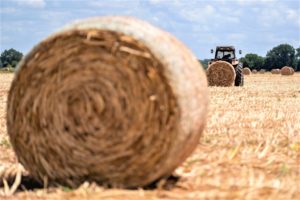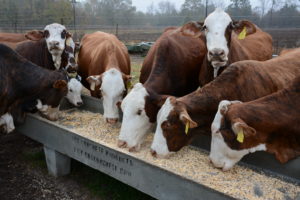Texas Crop and Weather Report – Oct. 12, 2022
OCTOBER 12, 2022

Jason Cleere, Ph.D., AgriLife Extension statewide beef cattle specialist, Bryan-College Station, said cattle producers face a range of challenges and concerns as herds enter fall and winter, particularly those related to rainfall between now and spring.
Producers need to minimize costs while maximizing their herd’s productivity through these challenges because cattle market outlooks are positive, Cleere said.
According to the U.S. Drought Monitor, rainfall events in mid-August through early September reduced the percentage of the state experiencing some form of drought. More than 99% of Texas was experiencing drought on Aug. 2 compared to 78% on Sept. 13, but the percentage has climbed back to 89% as of Oct. 4.
The next drought monitor report is expected to show worsening drought conditions due to recent high temperatures and lack of rainfall, he said. The weather is expected to shift toward an El Niño pattern by spring, but the lingering La Niña patterns, which typically deliver warmer, drier weather to most of Texas, have left big question marks for producers.
Cleere said many producers still face tough decisions on their herds related to the potential costs of keeping cattle based on their operation’s stocking rates and forage stocks. Some producers are facing decisions based on low pond or stock tank water levels.
Cow and calf prices are expected to rise following widespread herd consolidation across the state due to drought, he said. Producers should be mapping out their winter based on available grazing, forage and hay stocks, as well as expected costs for supplemental feed.
The goal should be to maintain a good body condition score going into the calving seasons so that those cows will breed back to ensure a good calf crop the following year, Cleere said.
“I am optimistic about cattle numbers and future demand over the next few years,” he said. “We could be poised to be as good or better than 2014-2015, so we need to be thinking about the calf crop that will be hitting the market, and the costs of pregnancy rates and supplementation through winter. My fear is that producers will try to cut corners, and that it could impact the calf crop, fertility and the timely breed-back of cows, which would impact the next year’s calf crop.”
Be efficient rather than cut corners
Nutrition is not the place to cut corners, Cleere said.
Producers should aim for a body condition score of five for cows at calving, he said. This provides a buffer for lactating cows that will help them maintain a good condition as they recover for breeding.
Improving an operation’s efficiency when it comes to animal nutrition can be done in several ways, he said.
Cleere recommends testing hay to determine the nutritive value and what type of nutritional supplementation may be necessary. Many hay producers reduced fertilizer applications due to higher nitrogen prices this season, and hay quality could be lower than normal.
“Hay supplies are much better than they were 60 days ago, but ranchers will still be cutting it close,” he said. “It’s a great idea to test hay and let that guide the supplemental diet in an efficient way.”
Producers should also look into purchasing supplemental feed in bulk rather than by the bag or pricing other supplements with nutrition per pound in mind, he said. Total digestible nutrients per pound of feed is an important consideration because some less expensive rations may include higher amounts of fiber, which reduces the energy value of the feed.

Cleere said producers could also consider pricing troughs to reduce waste.
“Under wetter conditions, you may lose 20%-30% of cubes, and you can see a lot of nutrition go to waste on the ground,” he said. “The key is looking for efficiency in our feed management and getting the most out of every dollar you spend.”
Winter pasture could be good investment
Warm-season pastures are playing out at this point.
The investment in winter pasture, including ryegrass, could be another way to provide efficient nutrition for cattle, Cleere said. But that option is heavily dependent on whether fields receive timely rainfall events to fuel germination, establish good stands and growth if winter temperatures are mild, or during spring green up.
“There is certainly an opportunity to overseed with ryegrass, especially with the lack of thatch in many pastures,” he said. “Fertilizer prices have come down, but the question is will it rain enough to get ryegrass pastures up and keep them going through spring.”
Cleere said overseeding ryegrass in East Texas typically begins around Oct. 15, but that very few producers were preparing yet due to the moisture situation. Producers should be ready to capitalize on positive weather patterns if they are looking to establish winter pasture.
During the drought in 2011, Cleere said his operation received its first rain the week of Thanksgiving. He overseeded a sacrifice pasture that was grazed down with ryegrass the day after Thanksgiving.
“It was a mild winter, we fertilized and we had good rain, and by the end of January we had a foot of ryegrass,” he said. “That turned out to be a perfect winter for that, but it started with being ready for the rain.
“The positive is the numbers and indications that we’re seeing good market predictions,” he said. “The negatives are what we are dealing with right now with the drought and the cost of everything. We’ll need those expected prices to see profits, and so we need to be doing everything we can to control costs without sacrificing herd production.”